Imagine a lush, tropical oasis in your own backyard or living room. Here, towering fronds sway gently in the breeze. Broad, vibrant leaves create a stunning visual display. This dream can become a reality with the incredible diversity of long leaf plants.
Some long-stemmed foliage can reach up to 15 feet in height and width. This can transform any space into a verdant, botanical wonderland. From the iconic banana tree to the elegant philodendron, the world of long leaf plants is vast.
It offers a wealth of ornamental grasses, tropical plants, and stunning indoor and outdoor botanical varieties. Whether you’re a seasoned gardener or a new plant enthusiast, these long leaf wonders can breathe life into your home or landscape.
In this comprehensive guide, we’ll dive into the alluring world of long leaf plants. We’ll uncover the unique traits and care requirements of some of the most popular and visually striking varieties. Prepare to be inspired and discover the perfect addition to your indoor or outdoor oasis.
Key Takeaways
- Long leaf plants offer a diverse range of ornamental grasses, tropical plants, and stunning indoor and outdoor botanical varieties.
- These plants can transform any space into a lush, verdant oasis with their towering heights and broad, vibrant foliage.
- Exploring the captivating characteristics of long leaf plants can inspire both seasoned gardeners and new plant enthusiasts.
- Variety is key, with options ranging from the iconic banana tree to the elegant philodendron.
- Understanding the unique care requirements of each long leaf plant is crucial for their successful growth and thriving in your home or landscape.
Elephant Ear Plants
Elephant ear plants, also known as colocasia, are loved for their huge, arrow-shaped leaves that can reach up to 3 feet long. These tropical perennials love warm, humid places and stand out when grown indoors or outside. Their thick, waxy leaves come in green, purple, or mixed colors, adding beauty to any area.
Characteristics
Elephant ear plants need soil that drains well and bright, indirect light to stay lush. But, they are toxic to humans and pets, so keep them away.
There are over 200 types of taro (Colocasia esculenta) now, chosen for eating or decoration. Most elephant ears are 3 to 5 feet tall, with some reaching up to 9 feet tall in perfect conditions.
New elephant ear varieties have become more common thanks to breeding efforts. The ‘Thailand Giant Strain’ of Colocasia gigantea, for example, can grow up to 9 feet tall with leaves up to 5 feet long and 4 feet wide.
Elephant ears do best in warm weather and high humidity. They may not do well if it gets colder than 50°F for a long time. Most types prefer partial shade, but dark ones look best in full sun.
“Elephant ears are tropical plants that thrive in hot and humid weather conditions.”
These plants need a lot of food and water, especially if they’re in pots. While often seen as annuals, many elephant ears can be kept through the winter.
Bird of Paradise
The bird of paradise, also known as the Strelitzia, is a stunning tropical plant. It has vibrant, bird-like flowers and large, glossy leaves. These leaves can grow up to 18 inches long and 6 inches wide.
This plant adds drama to any setting with its self-heading habit. It is native to South Africa and belongs to the Strelitziaceae family. This family is closely related to the Musaceae family of bananas.
While the plant is famous for its orange-and-blue blooms, there are also white varieties. Bird of paradise plants can sometimes flower indoors, but this is rare.

The bird of paradise needs bright, indirect light to full sun. It likes well-draining, acidic soil and should be watered every one to two weeks. The soil should dry out between waterings.
This plant also thrives in higher humidity levels. The ideal temperature is between 65°F to 85°F (18°C to 30°C).
This plant is usually pest-free but can get spider mites. It can also have issues like splits along the leaves, yellowing lower leaves from too much water, and wilting or curling leaves from not enough water.
It can be irritating if eaten by cats, dogs, and humans. So, keep it away from pets and kids.
The bird of paradise is a true showstopper with its unique blooms. It adds a touch of the tropics to any space. With the right care, gardeners can enjoy this remarkable plant for years.
Fiddle Leaf Fig
The fiddle leaf fig, also known as Ficus lyrata, is a beautiful indoor tree. It’s loved for its large, waxy leaves shaped like violins. These leaves can grow up to 10 inches wide and help the tree reach heights of 10 feet or more.
These plants come from the tropical rainforests of western Africa. They love bright, indirect light and soil that’s always moist but drains well. But, they can be tricky to care for, needing just the right conditions to stay healthy and look great.
Even with their challenges, fiddle leaf figs are a favorite among indoor plants. Their tall, tree-like shape and big leaves fit well with modern decor. They look great in bright living rooms, big foyers, and sunny bedrooms.
To keep a fiddle leaf fig happy, pay close attention to its needs. This means making sure it gets the right amount of light, water, humidity, and temperature. Regular cleaning, fertilizing, and pruning are also key to their success.
“Fiddle leaf figs are one of the trendiest houseplants available, thanks to their striking appearance and air-purifying qualities.”
Fiddle leaf figs are known for their unique look and ability to fit into many indoor spaces. By learning what these plants need, gardeners can enjoy their beauty and benefits at home.
Monstera Deliciosa
The Monstera deliciosa, also known as the “Swiss cheese plant,” is a beautiful houseplant. It has large, dramatic leaves that can grow up to 3-4 feet long. These leaves have holes that form as the plant grows, giving it a tropical look.
This plant loves bright, indirect light and well-draining soil. It’s easy to care for, making it perfect for indoor plant lovers.
Did you know there are over 40 types of Monstera deliciosa? Each variety has its own special look. For instance, the Monstera dubia can grow up to 10 feet tall. The Monstera standleyana has leaves with lighter green or white spots that look like holes.
The Hurricane Plant variety can grow 4-6 feet tall and has rough, bumpy leaves. The Matuda Monstera can reach 6-8 feet tall with dark green veins.
The Mini Monstera (Ginny) is a smaller type, growing 4-5 feet tall. It has the classic holes in its leaves. On the other hand, the Monstera acacoyaguensis can grow 4-20 feet tall with glossy, thin leaves.
The Monstera borsigiana is a compact variety, reaching 2-4 feet tall. Its leaves have large slits that look like holes.
“The Monstera deliciosa’s tropical, jungle-like appearance makes it a stunning addition to any indoor space.”
Even though it’s big and beautiful, the Monstera deliciosa is toxic to humans and pets. So, keep it away from them. But with proper care, it can be a great indoor plant that adds a touch of the tropics to your home.

What are some long leaf plants?
Philodendron Xanadu: A Stunning Foliage Centerpiece
Looking for a long leaf plant for your indoor space? The Philodendron Xanadu is a great choice. It has large, leathery leaves that can grow up to 16 inches long and 12 inches wide. As it grows, the leaves get even more detailed, with more lobes that make the foliage look lush.
This plant loves bright, indirect light and soil that drains well. It’s easy to care for, but keep it away from people and pets since it’s toxic. The Philodendron Xanadu’s beautiful leaves make it a standout in any room.
“The Philodendron Xanadu’s intricate, lobed leaves add depth and visual interest to any indoor setting.”
Rubber Tree
The rubber tree (Ficus elastica) is a favorite houseplant known for its big, waxy leaves. These leaves can grow up to 10 inches wide. Indoor plants like this one love bright sunlight and need regular pruning to stay manageable indoors. But, the rubber tree’s beautiful tropical foliage comes with a warning: it’s toxic to humans, cats, and dogs. So, be careful where you place it.
The rubber tree comes from southern China, Southeast Asia, and Indonesia. NASA recommends it for cleaning the air we breathe. The Ficus elastica and Hevea brasiliensis are used to make rubber. Even the roots of the rubber tree help create “living bridges” in tropical Northeastern India.
To keep your rubber tree happy, give it the right care. It needs 6 to 8 hours of bright indirect light every day. Water it every 1-2 weeks, letting the soil dry out first. Rubber trees like any humidity and prefer temperatures between 65°F and 85°F (18°C-30°C).
Outside, rubber trees can grow up to 30 ft. tall with a wide spread. Indoors, they can reach 6 to 10 ft. tall. They’re pretty easy to care for, but watch out for pests and prune them often to keep them looking good.
Rubber trees are toxic to pets and humans because of their milky sap. So, handle them with care and keep them away from pets and kids.

African Mask Plant
Distinctive Features:
The African mask plant, also known as Alocasia, is a stunning houseplant. It’s known for its big, green leaves with white or light green veining. This creates a beautiful contrast. The leaves are shaped like hearts or arrowheads, giving it a unique, tropical look.
This plant can grow up to 10 feet tall in the wild but stays shorter indoors, about 1-2 feet. Its leaves can be up to 3 feet long, adding a bold touch to any room.
Even though they look great, African mask plants are toxic to humans and pets. So, keep them away from kids and pets. With the right care, they can be a beautiful part of your tropical foliage collection.
Creeping Velvet Philodendron
Meet the captivating Creeping Velvet Philodendron, also known as Philodendron gloriosum. This plant is famous for its soft, deep green leaves with beautiful white veins. It’s a rare find for those who love indoor plants and want to add a touch of tropical beauty to their homes.
This philodendron loves bright, indirect light and soil that drains well. Its big, shiny leaves with a soft feel and unique veins are a sight to behold. This makes the Creeping Velvet Philodendron a favorite among indoor plant lovers.
But, it’s important to know that this plant is toxic to humans, cats, and dogs. So, make sure to keep it out of reach of pets and young children to keep everyone safe.

The Creeping Velvet Philodendron stands out with its soft texture, big leaves, and tropical look. It’s perfect for both experienced plant lovers and beginners in indoor gardening. This plant will surely amaze and inspire you with its beauty.
Banana Tree Plant
The banana tree, also known as the musa, is a beautiful addition to gardens. Its large, paddle-shaped leaves can grow up to 2 feet wide and 9 feet long. This creates a lush, tropical look. Banana trees do well both indoors and outdoors in warm, humid places.
Banana trees are known for being pet-friendly. They are also quick to grow, reaching 20 to 40 feet tall in just 10 to 15 months. This makes them a great choice for adding drama to any space.
There are over 70 types of banana trees to pick from. Dwarf varieties like the Musa acuminata ‘Dwarf Cuban Red’ and ‘Dwarf Cavendish’ are perfect for indoor spaces. They grow between 4 to 7 feet tall, offering tropical charm without needing a lot of space.
“Banana leaf plants should get at least six to eight hours of full sun each day,” advises Harris, a renowned horticulturist. “Proper sunlight exposure is crucial for maintaining their vibrant, healthy appearance.”
To keep your banana tree healthy, make sure it has the right conditions. They love humid environments and need moist, well-draining soil that’s a bit acidic. Don’t overwater, as this can cause root rot. With proper care, the banana tree can add tropical beauty to any area.
Majesty Palm
The majesty palm, also known as the Ravenna palm, is a beautiful indoor palm tree. It can make any space look great with its large, lush fronds. But, it needs the right care to grow well indoors. Let’s look at what care it needs to keep it healthy and looking good.
Care Requirements
Majesty palms love bright, indirect light. They need 6 to 8 hours of sunlight each day to do well. Without enough light, they might grow slow and have yellow leaves. So, put it near a sunny window or use a grow light to keep it happy.
Watering is key for majesty palms. They like their soil to be a bit moist but dry out between waterings. Water your palm every 9 days if it’s not in direct sunlight and is in a 5-inch pot. Adjust how often you water based on your plant’s needs.
Feeding your palm with fertilizer is also important. Give it food every 2-3 months in spring and summer with a balanced, slow-release fertilizer. This helps it grow big and strong.
Pruning is a must for majesty palms. Cut off any yellow or brown fronds to keep it looking neat and encourage new growth. Also, repotting it every other year helps prevent overcrowding and lets its roots grow.
With the right care, your majesty palm can thrive and be a beautiful part of your indoor plants. A little care goes a long way with this slow-growing yet majestic plant. It can brighten your home for many years.

“The majesty palm is a truly stunning indoor plant that can transform any space with its large, lush fronds. However, it requires specific care to ensure its long-term health and vigor.”
Round-Leaved Calathea
The Calathea orbifolia, also known as the round-leaved calathea, is a beautiful plant. It belongs to the prayer plant family. Its large, orb-shaped leaves can grow up to 3 feet tall.
This plant has stunning, vibrant green leaves with unique patterns. It’s a great choice for anyone who loves indoor plants.
But, the round-leaved calathea needs special care. It loves high humidity, needing at least 50% to stay healthy. Make sure to use distilled or filtered water and keep the temperature between 70-75°F (21-24°C).
Even with its high humidity needs, this plant is worth it for plant lovers. Its big, tropical leaves and unique look will catch everyone’s eye. Just remember to keep an eye on its moisture and give it bright, indirect light.
If you want to bring the tropics indoors, consider the Calathea orbifolia. With proper care, it can add a lush, green touch to any room.
Tropic Snow Dumb Cane
The Tropic Snow dumb cane (Dieffenbachia seguine) is a great choice for those who want a bold indoor plant. It’s known for its large, variegated leaves that can reach up to 10 feet tall indoors. This makes it a beautiful addition to any space with a tropical feel.
This indoor plant is easy to take care of and can grow well in various lighting conditions. It likes soil that drains well and has acidic pH levels. Water it when the soil feels dry, usually twice a week when it’s growing.
The Tropic Snow dumb cane is also known for being easy to care for. It’s a tropical foliage plant that can clean the air and live for many years with proper care. But, remember, it’s toxic to people and pets, so keep it away from them.
If you want to bring the tropics inside, the Tropic Snow dumb cane is a stunning and low-maintenance choice. Its large, variegated leaves and easy-care nature make it a favorite among indoor plant lovers.

“The Tropic Snow dumb cane is a true showstopper, with its bold, tropical-inspired foliage that can transform any indoor space.”
Conclusion
Long leaf plants add a unique touch to any space, indoors or outdoors. They bring a tropical feel with their broad leaves. The banana tree and Monstera deliciosa are just a few examples of these plants.
These plants can make your space look lush and jungle-like. Or, they can be a bold, sculptural piece in your home. The right long leaf plant can be a stunning centerpiece.
Knowing how to care for these plants lets you enjoy their beauty for years. Long leaf plants are great for adding a statement to your space. They bring the beauty of nature indoors or outdoors.
For those who love tropical plants, long leaf plants are a must. They are perfect for any plant or home decor lover. By choosing the right long leaf plant, you can make your space feel lush and peaceful.



I don’t think the title of your article matches the content lol. Just kidding, mainly because I had some doubts after reading the article.